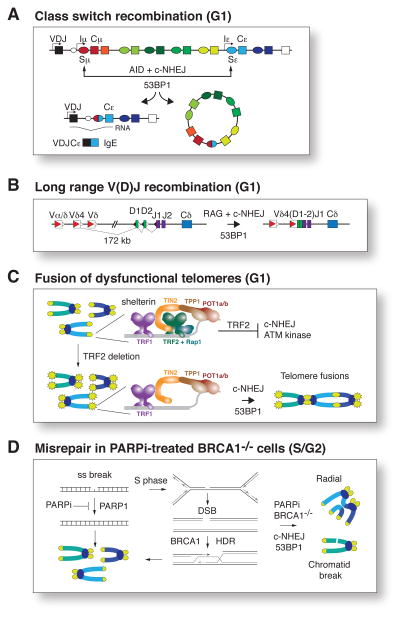Figure 2.
53BP1 contributes to c-NHEJ in four contexts. 53BP1 is involved in the c-NHEJ in G1 in three specialized contexts: (A) CSR, (B) long range V(D)J recombination, and (C) the fusion of dysfunctional telomeres deprived of TRF2 protection. In (A) the Switch regions where AID induces DSBs are shown by ovals and their associated Constant regions by rectangles with the same color. Joining Sμ to Sε results in productive CSR, yielding IgE and a deleted segment (circle). Iμ and Iε are transcription start sites that promote switching. In (B), and example of long-range V(D)J recombination is given where RAG-dependent recombination joins a Variable (V) region to a D/J region 172 kb away (adapted from [47]). In (C), the shelterin complex at telomeres is shown before and after the deletion of TRF2, which results in ATM signaling and c-NHEJ of the dysfunctional telomeres in G1. These fusions are visualized as the chromosome-type fusions (drawn) in the following metaphase. In (D), the role of 53BP1 in BRCA1-deficient cells is shown. In S/G2, 53BP1 promotes the formation of mis-rejoined chromosome aberrations and inhibits HDR, leading to radial chromosomes and chromatid breaks as shown. This role of 53BP1 is only observed in BRCA1-deficient cells and is enhanced by treatment with PARP1 inhibitors, which lead to DSB formation in S/G2 (as depicted). Not shown is the fifth setting, DSB repair in heterochromatin, where 53BP1 acts through an unknown mechanism that involves its BRCT domains, which are not required for the processes shown in A–D.

